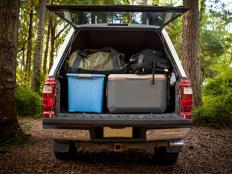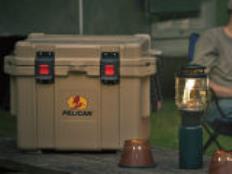Using an External Hand Pump
1. Follow Steps 1 to 6 above to drain all the water. Blowing out the system with compressed air is preferred but not mandatory. What is mandatory is that the water heater be bypassed; otherwise, you'll need an additional 6 to 10 gallons of RV antifreeze to complete the process properly.
2. Attach the intake siphon on the hand pump to the RV antifreeze bottle (follow manufacturer's instructions). Then connect the output hose on the pump to the city water inlet.
3. Close all faucets and drain valves. Open the hot side of the highest faucet first (usually the kitchen sink). Pump the antifreeze into the system until it runs out the faucet a bright pink color.
4. Close the hot side, open the cold side and repeat. Close the cold side.
5. Do this for all the other faucets. Usually the bathroom sink is next, then the shower, and then the toilet.
Using the RV's Internal Water Pump
This method is virtually identical to the external hand pump. The only difference is that the water pump bypass valve is used to draw RV antifreeze into the pump and distribute it throughout the water system. Consult the RV pump bypass valve instructions for details.
Tires
Your tires can develop flat spots after several months because they're under thousands of pounds of weight. If your RV has leveling jacks (not stabilizing jacks), follow the manufacturer's instructions on raising your rig off the ground for extended periods. Outside jacks are an alternative method. If neither is available, then move your RV about one-half tire revolution one or two times a winter to re-distribute the weight.
Your rig should be parked on a paved or concrete surface to prevent the tires from sinking into ground made soft by winter thaw. And be sure to set the parking brake (motor homes) and use wheel chocks.
Stabilizing Jacks
Your stabilizing jacks should be lowered to keep your trailer or 5th-wheeler steady while you're walking around inside. Use wooden blocks beneath the jacks' feet to prevent them from getting frozen to your storage pad. Coat all pivot points with silicone or graphite spray to prevent rust.
Engine
For a motor home, top off the fuel tanks to prevent condensation from forming. Also, add a fuel stabilizer. Let the engine idle for several minutes to allow the additive to make its way through the system. Make sure the radiator is filled with automotive antifreeze. Check the oil, brake fluid and windshield washer solution. Make sure the windshield washer solution is factory formulated with antifreeze. Top off as needed.
Batteries
Fluid levels in maintenance-style batteries should be topped off (wear eye protection and rubber gloves). Batteries should be fully charged. In freezing climates, remove batteries of any type and store in a dry warm location. Otherwise, disconnect the cables (negative side first) for safety.
Electrical System
Flip off the RV's main circuit breaker to protect the 120V AC system. Disconnect your rig from shore power. Remove batteries from clocks, radios, detectors and alarms. See manufacturer's instructions for onboard or portable generator storage. Be sure to block the exhaust pipe with steel wool or aluminum foil to keep out pests.
- 2
- of
- 3








Discuss This Article